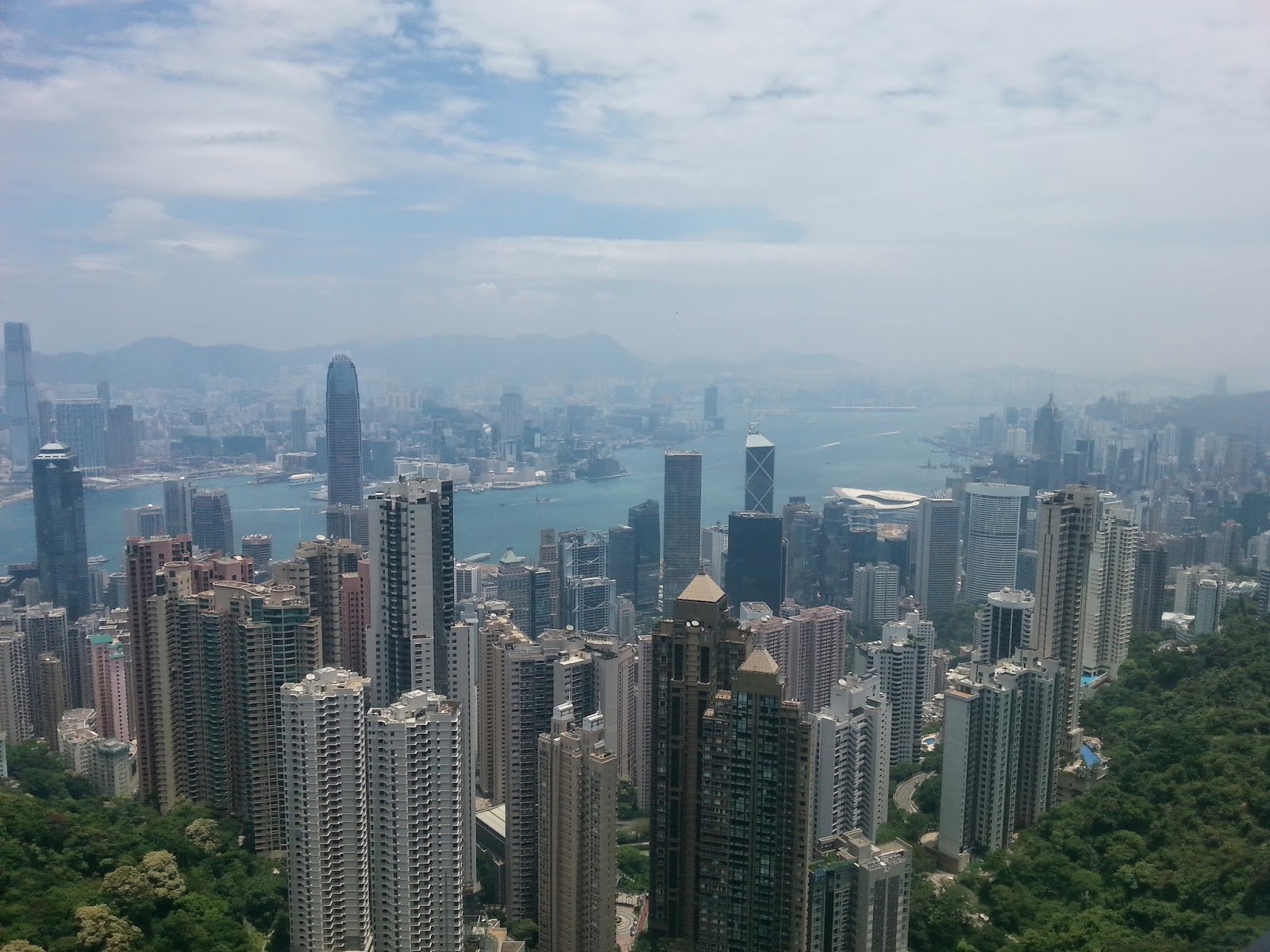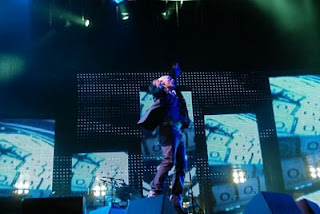Hong Kong
Ok, I know I’m not meant to flaunting my ignorance by highlighting
Asian place names, but Hong Kong has a district called Mong Kok.
Mong Kok.
Apparently it’s the most densely populated part of what is
the most sardine tin-like place on earth, and you can certainly believe that as
you come out of the metro station onto a narrow main road packed with shops and
pedestrians and surrounded by overpasses and subways. Walk up a few blocks to
the various markets and you feel a little less claustrophobic, but this is a
relative term in this vertical city-state, where our hotel’s reception was on
the 5th floor due to lack of surface space and where giant hills lurk
beyond any mid-skyscraper gaps.
 |
| View from the Peak |
Said markets, by the way, are technically rows of themed
shops. The flower market is pretty standard stuff; the fish one less so, most
of its wares being bulging bags of goldfish (considered lucky by the Chinese)
plus the odd tank to put them in; the bird one though is like the Hitchcock
film made flesh – a sensory overload of squawking creatures crammed inside tiny
cages while their untamed feathered cousins buzz manically around the
customers’ heads.
It’s fair to say that Chinese attitudes towards animals are somewhat
different to ours. Some of the fish market stores also had kittens, puppies and
gerbils on display, none of which exactly had much breathing space – a reminder
as to why we don’t tend to have pet shops anymore. And then there are the
innumerable foodstuffs and medicinal products – around the corner from our
hotel in Sheung Wan were rows of wholesalers peddling birds’ nests, dried fishy
things and the waft of pungent aromas from a plethora of unidentified
ingredients.
The contrast between such Chinese traditions and the
ultra-modern, Manhattan-style cityscape is what makes Hong Kong tick. Turning
away from the glimmering main streets with their luxury malls brings you to
narrow sidestreets full of market stalls which bear a considerably more Eastern
flavour. These alleys slope gently upwards before the terrain turns properly
steep, culminating in the beautiful Victoria Peak. It goes without saying that
the steep, near-vertical tram ride up the Peak is a must-do, and they’ve
helpfully plonked a couple of shopping centres next to the summit station as
well as the main viewing deck, in an attempt to keep you up there for a good
while.
I was pretty ignorant of Hong Kong’s geography until first
perusal of the guidebooks a couple of months ago, and certainly had no idea
that it includes nearly 1000 square miles of the New Territories, well away
from the hotspots of the island’s North coast and Kowloon across the harbour.
As we only had a couple of days here we didn’t get to see any of ‘the
countryside’ or attempt any of the longer walks from the Peak, but certainly
anyone thinking of visiting HK but put off by the big city thing should be
aware that it has much more to offer, including beaches on the island’s south
side. (And there’s a Disneyland too, obviously.)
 |
| Probably my favourite shop in the world |
With real estate at a premium and the main island seemingly at
near saturation point, more and more housing has been built on the slopes. Many
City workers thus make their unusual daily commute from the so-called Mid-Levels
via the longest outdoor escalator in the world. That this modern metropolis has
developed only in the last century or so, with the region previously playing
host to little more than villages before the Brits appeared on the scene, is
also intriguing. Allegedly this is down to the territory’s ‘good feng shui’,
being a natural harbour surrounded by big hills, or maybe, y’know, harbours are
just pretty good in terms of economic development once occupied by people who
know how to use them. Nonetheless feng shui is a big deal – bad shapes such as triangles
are a no-no in buildings, and one tower even has a hole in it to facilitate the
flow of energy into the sea or some such nonsense.
 |
| Sorry, weather was pretty bad that day. Attempts at capturing the Festival of Lights were even worse. |
I knew even less about HK’s history, which was why I found
the Museum of History in Kowloon such a worthwhile visit. I wasn’t exactly
surprised to discover that Britain came to own the place through a belligerent
combination of bullying, warfare and flooding it with opium, just rather
depressed at the shittiness of human behaviour in general, though I guess you
don’t get to rule over half the world by playing nice. ‘China ends 156 years of
shame’ was the hard-to-argue-with headline of one local paper on handover day
in 1997. That the Japanese rule of HK during World War II was even worse
doesn’t offer much consolation. However, its success as a modern melting pot for
two very different cultures offers some hope for other cities aspiring to that
goal.
There are all sorts of quirky cultural differences to fascinate
tourist eyes. Any surfaces where hands are frequently placed, such as lift
buttons and escalator handrails, bear notices to reassure you that they are
disinfected several times a day. Presumably this over-cautious approach to
public health is a legacy of the early Noughties SARS outbreak, although
regrettably this fastidiousness does not extend to most public toilets. And I’ve
always questioned the usefulness of the surgical masks that many people were in
public. I particularly enjoyed the guy who’d paused on a street corner and
removed his so that he could enjoy a presumably ironic fag.
Allied to this is a relentless obsession with cutting-edge
technology. Other signs on the metro warn punters of the perils of walking
around with your eyes glued to your phone or tablet screens, signs which are
universally ignored. The modernity of HK’s infrastructure is impressive though
– the gleaming new airport was constructed from scratch on reclaimed land on a
neighbouring island, and the express train connecting it with the city centre
is staggeringly efficient.
But then, if you like your public transport to be a little
more traditional there are dinky little narrow-gauge trams and the old-school Star
Ferry to take you between the island and Tsem Sha Tsui on the tip of Kowloon on
the mainland side. As well as various museums and some of the poshest hotels
(afternoon tea at the Peninsula was lovely, although you can’t book so be
prepared to queue), TST boasts the decidedly low-rent Avenue of Stars, HK’s
equivalent of the Hollywood Walk of Fame featuring a statue of Bruce Lee, some fried
squid stands and handprints of Jet Li, Jackie Chan and hundreds of other actors
you’ve never heard of.
 |
| Times Square (not that one) |
However, this is the place to stand at 8pm if you want the
best view of the Festival of Lights, where the biggest skyscrapers show themselves
off with oodles of neon and lasers. Frankly though, the skyline looks
impressive enough at night even without the added tackiness. It’s also well
worth walking up and around Nathan Street, especially at night with all the neon
craziness in full flow. You can play a fun game of ‘count the Chow Tai Fook
jewellery stores’ while you walk - seriously, there are hundreds of branches all
right near each other. Just ignore the hustlers trying to interest you in
watches or suits – I’m not sure where they take you if you say yes, but I didn’t
want to find out (and it’s probably not Chow Tai Fook).
Finally, I don’t tend to go on about food as there are
plenty of people out there far more qualified to discuss it than me (yeah I
know, that doesn’t stop me though LOLZ), but we enjoyed some superb Chinese
cuisine in a restaurant called Hutong, as well as a bonus noodle-making display
by one of the chefs. They have a branch in the Shard which should be well worth
a visit, although about twice as expensive.
 |
| Sorry, another crap photo. There was lots more neon than this, honest. |
A subway in Tsem Sha Tsui displays some ‘inspirational’
quotes, one of which particularly raised my hackles. ‘The world is a book, but
those who don’t travel only see one page’ is at best pompous and at worst a terrible
two-fingered salute to those with no means to leave the places in which they
were born. But most annoyingly of all, visiting a place like Hong Kong confirms
that this trite little aphorism is entirely true. Still, those of us lucky
enough to be able to jet off halfway across the globe for a holiday shouldn’t
ever take it for granted.





Comments